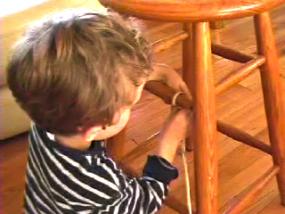What Is Not a Knot to What Is a Knot

It takes careful thinking for a child to thread a looped string and pull it tight to create a knot. Children begin this learning process in stages, first making a loop without threading one end through its center, pulling tight, only to see the string flat again. In this video clip we see four children apply this and other strategies that all make some sense, even if they don’t quite tie the knot. Watch Ayla work to keep a bead from falling off Tucker’s necklace. She pushes the bead far from the end as if that is part of the solution. When it slides down, she angles the string acutely, as if the angle will hold the bead up like a hook (00:31). But a hook is not a knot. She threads one end of the string through the wrong side of the bead on the string, not realizing the loop she made will exit the bead when she pulls the string tight (00:44-00:53). A loop is not a knot. Toward the end it looks like she wants to tuck one end of the necklace into the complete knot on the other end of the necklace. She knows that the end of the string has to fit inside something in order for the necklace to hold together. But there are other requirements that she has not yet learned. Watch Kaylee tie a string to a spindle on a chair. She loops the string around the spindle and then twists the two strands around each other to close the loop, like a twist tie on a bread bag (01:17-01:32). But the limp string does not hold, and the twisted loop falls apart (01:33). A twist is not a knot. So she wraps the string around the back of the spindle, seeking some way for the string to hold (01:35). A wrap is not a knot. Perhaps to take up the extra string, she continues to wrap the string around adjacent spindles making a rather tangled mess. As she gets to the end of the string, she shifts her attention to putting one end of the string through another part of the string that loops around the spindle (02:02-02:18). This is the way to make the string close on itself to make a secure knot, but her tangle makes it too difficult for her to find her way to making a clean knot. Making the string close on itself when pulled is a knot. Watch Ben tie a dog’s leash to a stool. Saying, “One” as he wraps the rope around a rung on the stool (02:32) suggests that he is thinking about a series of steps. As if rehearsing these steps, Ben pauses to form a loop and says, “Loop” (02:34 – 02:36). He then goes to his next step by wrapping the rope over several rungs (02:46 – 02:58). Like Kaylee, Ben may assume that wrapping will better secure the rope. For most children, a strategy that works partially is difficult to abandon completely. Ben recognizes that the remainder of the string is too short to tie a knot. He releases the string, allowing it to unravel from the leg and lower rung. Then he wraps the rope around an upper rung (03:08), tucks the end under the loop, and pulls it tight (03:37). A loop that closes on itself is a knot. Watch Chaislyn help a friend, Alyssa tie a shoe lace into a bow. The challenge of a bow is hugely more complex than the challenge of a simple knot. (Click here to view a video that walks through this complexity.) A bow does start with the over-under-through-and-pull sequence of a simple knot. Chaislyn has learned the over-under and the pull, but has not added the through. In other words, she twists the two lace segments and pulls the ends in opposite directions, yielding a tight twist that does not close on itself (03:54-04:11). A tight twist is not a knot. This episode goes for 14 minutes (see the videative, Takes Two to Tie a Shoe), but here we jump to her attempt to actually tie a bow. She creates a loop by pinching the lace at the base of the loop, the loop one usually wraps and ties a knot at the base using the other lace (04:20). But the open space of this loop captures her attention. She inserts the tip of the other lace through this opening in the loop (04:24). Pulling tight yields only two completely separate laces. Threading a pinched loop is not a knot. However, threading a loop that closes on itself does make a knot. (And threading the eye of the loop is the wrong step in making a bow.) Using the string as both the thing that ties (wraps over part of the string) and the thing that is tied (closing on itself) represents complex logic. Clearly we need to be patient with children as the make the journey from what is not a knot to what is a knot. Keywords: Children-Object, String, Spatial Relations, Logic Length of video: 4 minutes 44 seconds
